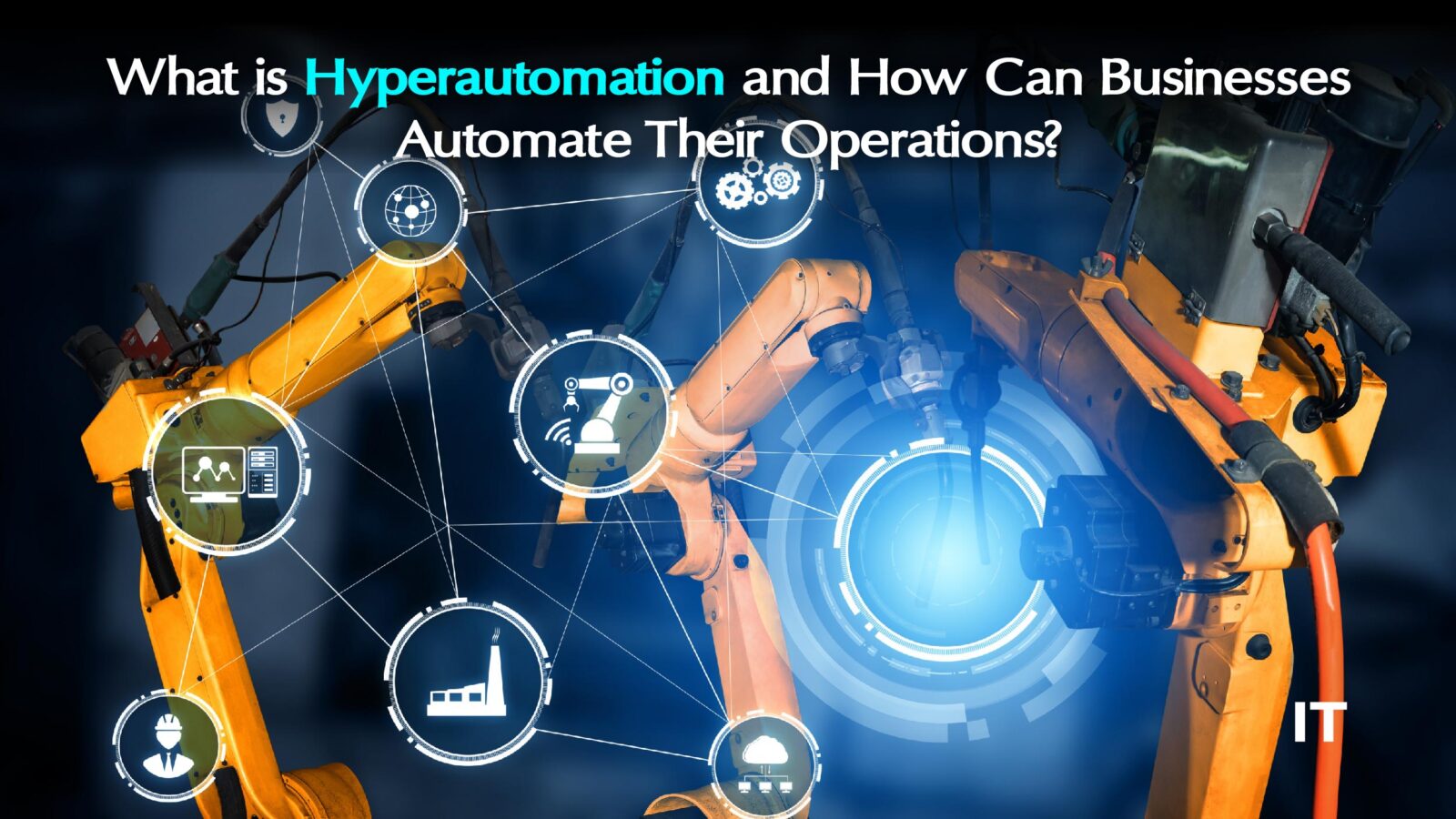As a business owner, you’re familiar with the challenges of managing your operations. With automation tools like no-code/low-code software, AI, and machine learning, is it still essential to hire personnel for every role?
If you find yourself asking that question, well, the answer is a BIG NO.
Hyperautomation enables you to automate everyday tasks. This industry is booming and expected to reach a value of $31.95 billion by 2029. In this article, we’ll explore how to automate your business efficiently, discussing best practices and crucial mistakes to steer clear of.
What Is Hyperautomation?
Hyperautomation involves automating all feasible processes within an organization, leveraging AI, RPA, and other technologies to enhance efficiency. It combines various advanced tools to streamline operations and continually identify new automation opportunities without human involvement.
The purpose of hyperautomation is to improve business processes and operations by automating as many tasks and workflows as possible. It aims to streamline operations, increase efficiency, reduce errors, and free up employees from repetitive and mundane tasks.
How is Hyperautomation Different From Automation?
 Automation and hyperautomation are closely related, yet they represent two different concepts. Automation involves the execution of repetitive tasks devoid of manual intervention, usually on a limited scale, focusing on individual task solutions. Conversely, hyperautomation encompasses the utilization of diverse automation tools, including machine learning and robotic process automation, to facilitate intelligent automation, enabling the scalability of automation endeavors.
Automation and hyperautomation are closely related, yet they represent two different concepts. Automation involves the execution of repetitive tasks devoid of manual intervention, usually on a limited scale, focusing on individual task solutions. Conversely, hyperautomation encompasses the utilization of diverse automation tools, including machine learning and robotic process automation, to facilitate intelligent automation, enabling the scalability of automation endeavors.
Also Read: Will Quantum Computing AI Be the Next Big Thing?
How to Hyperautomate Your Business?
Here are several essential steps and components to guide organizations through their hyperautomation journey:
- Gain insights into processes and workflows: Utilize process mining techniques to thoroughly investigate existing processes, workflows, and the operational environment. Identify areas of inefficiency, bottlenecks, and latency while also pinpointing opportunities for digital process automation. Some organizations may opt to create digital twins—a duplicate model of a process—to gain a clearer understanding of processes, inputs, outcomes, and areas for enhancement.
- Identify Data Requirements: Determine both structured and unstructured data needed to execute the identified processes effectively. Comprehensive data identification ensures smooth operation and accurate outcomes throughout the automation process.
- Predict Outcomes and ROI: Forecast the anticipated efficiencies and return on investment (ROI) associated with complete automation initiatives. Establishing clear outcome expectations enables organizations to measure the success and effectiveness of their efforts.
- Select Automation Platforms and Technologies: Choose automation platforms and technologies that align with your organizational needs and goals. Consider leveraging existing tools, algorithms, and technologies such as robotic process automation (RPA), optical character recognition (OCR), artificial intelligence (AI), and machine learning (ML) to design purpose-built bots for automated task execution.
- Automate Complex Processes: Implement automation solutions to streamline and optimize complex business and technology processes. It often involves automating not only manual tasks but also automated processes to achieve greater efficiencies and continuous cost reductions.
- Leverage AI Tools and Low-Code/No-Code Platforms: Employ AI-powered tools, including cognitive learning, OCR, and natural language processing (NLP), to enhance automation capabilities and achieve desired tasks efficiently. Additionally, incorporate low-code or no-code platforms featuring graphical user interfaces for configuration, simplifying the automation process and enabling faster deployment with minimal technical expertise required.
Benefits of Hyperautomation
- Operational Efficiency: By automating manual and repetitive tasks, it improves operational efficiency, reduces processing time, and increases productivity.
- Cost Savings: Automation reduces the need for manual labor, leading to cost savings for organizations. It optimizes resource allocation and improves overall cost-effectiveness.
- Improved Accuracy: It minimizes the risk of human errors that can occur during manual processes, resulting in improved accuracy and quality of work.
- Enhanced Customer Experience: Automation enables faster response times, personalized interactions, and improved customer service, leading to enhanced customer satisfaction and experience.
- Agility and Scalability: It allows organizations to quickly adapt to changing business needs and scale their operations. It provides flexibility and agility in automating new processes and workflows.
- Data-Driven Insights: Automation generates valuable data and insights that can be used to analyze and optimize processes further. Organizations can gain insights into process performance, identify bottlenecks, and make data-driven decisions for continuous improvement.
How does Hyperautomation Work?
 Identify Automation Opportunities: The first step is to identify processes and tasks that can be automated. This involves analyzing existing workflows, gathering insights on processes, and using techniques like process mining to understand how processes operate and identify areas for improvement.
Identify Automation Opportunities: The first step is to identify processes and tasks that can be automated. This involves analyzing existing workflows, gathering insights on processes, and using techniques like process mining to understand how processes operate and identify areas for improvement.- Evaluate and Select Technologies: It involves the orchestrated use of multiple technologies, such as AI, machine learning, RPA, BPM, and intelligent business process management suites. Organizations evaluate and select the appropriate technologies based on their specific needs and requirements.
- Design and Develop Automation Artifacts: Once the automation opportunities are identified and the technologies are selected, organizations design and develop the automation artifacts. This may include creating bots, scripts, workflows, or other automation components that utilize the chosen technologies.
- Implement and Integrate Automation: The automation artifacts are implemented and integrated into the existing systems and processes. This may involve integrating with legacy systems, APIs, or other software applications to ensure seamless automation across the organization.
- Monitor and Optimize: It is an ongoing process that requires continuous monitoring and optimization. Organizations track the performance of automated processes, gather data and insights, and make improvements to enhance efficiency, accuracy, and effectiveness.
- Scale and Expand Automation: As organizations gain experience and success with this advancement, they can scale and expand automation efforts to automate more processes and tasks across different departments and functions. This allows for greater efficiency and productivity gains.
Examples of Hyperautomation
Below are its examples in healthcare and supply chain management.
Hyperautomation in Healthcare
The healthcare industry can significantly benefit from complete automation, enhancing patient experiences, improving financial outcomes, and ensuring more accurate data management. Key applications include:
- Billing Cycles: Automating billing processes to streamline operations and improve efficiency.
- Customer Communication and Collection: Enhancing communication with patients and automating the collection process.
- Patient Record Management: Automating the collection, collation, and analysis of patient data to provide more accurate treatment plans.
- Regulatory Compliance: Ensuring adherence to regulations, which is crucial for the success and viability of healthcare organizations.
- Drug Inventory and Procurement Management: Automating inventory checks and procurement to maintain optimal drug stock levels.
- Staff and Resource Scheduling: Efficiently managing the scheduling of staff and other resources.
It offers numerous applications in healthcare, delivering improvements across the organization, benefiting partners, and enhancing patient care.
Hyperautomation in Supply Chain
The pandemic has disrupted material supply and staffing levels, leading to delays and logistical challenges. Complete automation can address these issues through:
- 24/7 Inventory Stock Checks: Using RPA to continuously monitor inventory levels and product availability.
- Procurement and Pricing: Automating procurement processes, pricing, and billing to streamline operations.
- Quote Requests and Follow-Ups: Enhancing efficiency by automating quote requests and follow-up actions.
- Data Input and System Maintenance: Removing manual intervention from repetitive tasks to increase speed, efficiency, and accuracy.
Businesses can overcome supply chain disruptions, ensuring timely material receipt and maintaining operational efficiency.
Bottom Line
Hyperautomation uses AI, machine learning, RPA, and other technologies to automate and optimize business and IT processes. By identifying automation opportunities, selecting the right technologies, designing and implementing automation solutions, and continuously monitoring performance, organizations can achieve operational efficiency, cost savings, improved customer experience, agility, and data-driven insights. It is a transformative approach that paves the way for increased productivity and competitiveness in the digital age.

































